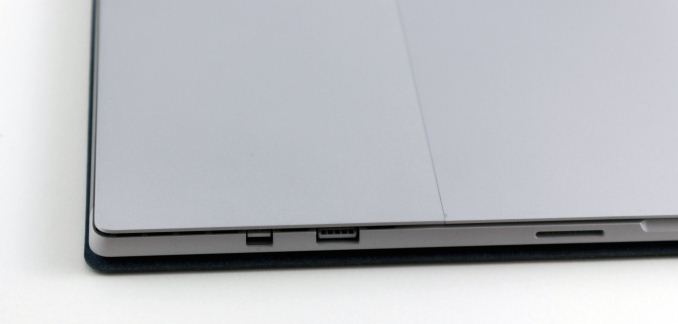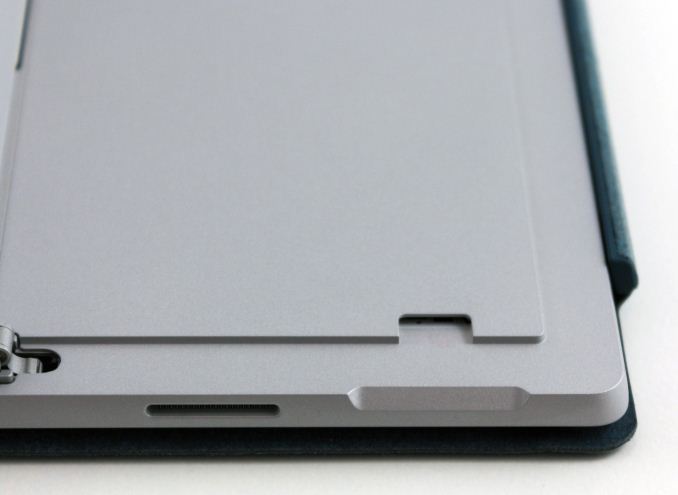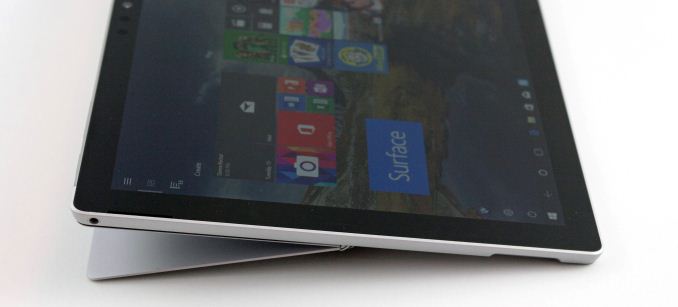The Microsoft Surface Pro (2017) Review: Evolution
by Brett Howse on June 15, 2017 9:00 AM ESTDesign
The Surface Pro 3 brought about a revolution in the design of the Surface Pro family, bringing the 3:2 aspect ratio that is now the signature on all Surface devices, as well as a much thinner and lighter design. Surface Pro 4 evolved that design, bringing a slightly larger display into the same size chassis, while becoming a bit thinner and lighter again. The new Surface Pro continues that evolution-rather-than-revolution philosophy, and that’s arguably the right choice for a successful product.
The latest design has softened the exterior, moving away from the angular design that has been a part of Surface Pro since the beginning. The edges are now slightly rounded, but without radically changing the look. The new rounded sides provide an improved in-hand feel, without the uncomfortable sharpness of the older generations.
The design is familiar though, with the same silver color on the chassis, along with a thin plastic RF window at the top, where the power and volume controls are. The left-side features the 3.5 mm headset jack, the right-side features all of the ports, and the bottom has the keyboard connector.
Speaking of the ports, they are exactly the same as the Surface Pro 4. There’s a USB-A port, a mini DisplayPort, and the Surface Connect for power and expansion. For those that need to add a bit more storage, the new Surface Pro continues to offer a micro SD slot too.
The lack of USB-C with Thunderbolt 3 in a high-end 2017 device is definitely a knock against the new Surface Pro. Microsoft’s reasoning is that USB-C is a port with too many options, and no two ports are guaranteed to be the same, which will lead to customer confusion. There’s also the argument that most of our devices still use full-sized USB, so Microsoft has stuck to its guns and just kept the USB-A port. They aren’t wrong about USB-C being confusing, though. Other than USB data, which is the one thing that all USB-C should support – although not always at the same speed – ports can support displays, higher power levels, Thunderbolt 3, and more. The counterpoint to this argument is that Surface Pro could offer a USB-C that features everything, although it would cost not only in terms of actual cost, but also space for extra chips, and in a small device like the Surface Pro, space is at a premium.
Their other argument is that, at least currently, almost anything that connects to USB-C needs an adapter or dongle of some sort, and that’s also true. But the counter to that is that the Surface Pro features a mini DisplayPort, which arguably needs a dongle or special cable to connect to almost anything anyway. A USB-C could offer the same DisplayPort signal, but way more.
There’s no argument that keeping the USB-A port is the right idea for today, but it would have been nice to see Microsoft adopt the new standard for the future, since a device with this kind of price has to have the expectation that it will still be around in several years, when USB-C will be more widespread.
The Kickstand
The one area that Microsoft both pioneered – and continued to evolve – is the kickstand. Looking back at the original Surface devices, the kickstand really the key to the entire device, allowing Surface to quickly and easily be used as both a tablet, and a laptop. The latest kickstand improves everything, again.
The biggest change is that the kickstand now opens even wider. The opening arc increases from 150° to 165°, which gives the Surface Pro an even better platform for using the Surface Pen, and accessories like the Surface Dial, which works right on the display, just like the Surface Studio.
The new kickstand seems to be even smoother than the Pro 4, and still offers just the right amount of friction to not allow the Pro to change angles when using touch on the display.
The kickstand is still one of the signature features of the Surface Pro, and it’s great to see it continue to improve.
Cooling Upgrades
The Surface Pro 4’s cooling was a big improvement over the Surface Pro 3, greatly reducing CPU thermal throttling, but also being quieter. The new Surface Pro develops on this again. When the Surface Pro 4 launched, the engineers let us know that they felt that the cooling system could dissipate the full 15-Watts of heat from the CPU passively, but they still included the fan on both the Core i5 and Core i7 models for the Surface Pro 4.
The new Surface Pro ditches the fan completely on the (15W) Core i5 model now, leaving just the (15W) Core i7 model with active cooling. Microsoft hasn't yet sampled this model of the Surface Pro, but hopefully we’ll be able to test it out soon to see what ramifications that changes has for performance. For noise though, it’s all good news, since it should be practically silent.
The Core i7 model, that we do have for review, is even quieter than the outgoing Pro 4, especially when at its default settings. So despite the active fan, the cooling system is much quieter. The cooling vents have been changed as well, with a much more subtle look to them on the new Pro.
The cooling changes have all been positive, and we’ll check out the performance of them later in the review.













124 Comments
View All Comments
serendip - Thursday, June 15, 2017 - link
Microsoft sells a tiny foldable Bluetooth keyboard with an Alcantara covering. I've been using it for months and it still looks good. It's a lot easier to unfold the keyboard when I need it and I can use the tablet without an attached keyboard in tablet mode. These cover-type keyboards add extra weight and make the tablet hard to use as a tablet.SaolDan - Friday, June 16, 2017 - link
I own a SP4 for personal use and a Huawei matebook for work. Let me tell you that you get used to the keyboard cover and stand theres no going back. i wish my company would give me a sp4 or the new one instead of the matebook. matebook can keep the type c. Type c is very nice but not that necessary for work.simard57 - Wednesday, June 21, 2017 - link
how would you compare the Matebook to the SP4?simard57 - Wednesday, June 21, 2017 - link
my past buying habits were mid level laptops - not top of the line ultrabooks - and the hinge is the Achilles heel of them. plastic and metal hinges are not made for a long marriage. the old adage, you pay for what you get, surely does applytipoo - Thursday, June 15, 2017 - link
Not everyone uses the same coatings on it. Microsoft has shipped alcantara Surface keyboards for years and they hold up well on average. The iPad Pros Apple fabric keyboard, whatever that fabric is, wears more in weeks, Microsofts is still the best fabric tabletey keyboard solution.
BillBear - Thursday, June 15, 2017 - link
If a spray on coating could make the Alcantara covered steering wheels on a Porsche hold up to wear, they would most assuredly already be using it.However, if you check out the video above you'll see that this is simply not the case.
mkozakewich - Saturday, June 17, 2017 - link
If you're talking about that video they posted on Reddit, someone else said the 'wear' is actually just grime that can be washed off.Everyone clings so hard to the marketing material. If the original Type Cover wasn't Alcantara, it was at least something very similar. It had a wonderful feel and withstood the years well. It washed well, too, and looks great even today. I could never stand the weird felt-like stuff they've been using the last few years.
Manch - Saturday, June 17, 2017 - link
My original Surface Pro KB is just fine. The track pad has bit of visible wear but other than that, its still nice. BillBear has been going on and on about the damn Alcantara but you can get a keyboard without it so I don't understand the grief. Anncedotal evidence of Porsche steering wheels, doesnt prove anything. The material is used on all kinds of things with no issues.Brett Howse - Thursday, June 15, 2017 - link
Only time will tell if the polyurethane coating on the Surface Signature Type Cover holds up well, but I've been using the Surface Ergonomic Keyboard on my desk for over six months now, and the Alcantara still looks almost new. YMMV, of course, but the normal Surface Type Cover can get beat up too. I don't see this as the major downside of others. At worst, it's going to be about the same as what we've already got.Manch - Saturday, June 17, 2017 - link
Or you could buy the regular type cover with or without the fingerprint sensor instead of the Alcantara